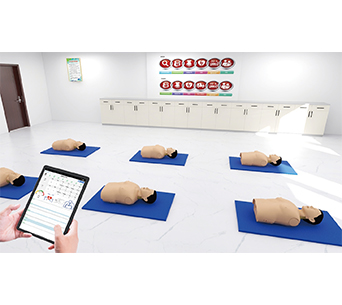■ The upper body of an adult male has clear anatomical landmarks, realistic nipples and xiphoid processes, making it easy to operate and locate. The head can rotate 180 degrees left and right, and the jaw joint can move.
■ Simulate the accurate anatomical position of the human head and neck, with the head able to swing left and right and rotate horizontally 180 degrees, making it easy to remove oral foreign objects.
■ Executive standard: 2020 American Heart Association Guidelines for Cardiopulmonary Resuscitation and Cardiovascular Emergency.
* Feasible chest compressions
* There are three feasible methods to open the airway: lifting the chin, neck, and jaw with both hands.
■ It is feasible to perform mouth to mouth artificial respiration or use a simple respirator to assist breathing. When using a simple respirator for breathing, the correct operation can be seen on the display screen showing the correct blowing volume and the simulator's chest undulating.
■ The eyeball adopts OLED simulation, with visible colored retina, black pupils, transparent crystals, and the ability to reflect light at any angle; In a dead state, the pupil dilates and the reflex to light disappears.
■ Palpable carotid artery pulsation, in a state of death, carotid artery pulsation disappears.

■ The system is divided into a student end and a mentor end, and the mentor end can connect at least 50 simulated people to conduct assessments simultaneously.
Teacher end:
■ CPR operation standards can be set, including CPR operation time, number of cycles, pressing depth, pressing frequency, pressing compliance rate, blowing volume, blowing compliance rate, etc.
■ Support the input of student information, including name and student ID. Real time display of the total number of presses and blows per student, as well as the correct and incorrect numbers. Real time display of online information of students, differentiated by different colors, intuitive and clear.
■ Real time feedback on the operation of each student, including the depth and frequency of pressing, whether the pressing rebounds, and whether the blowing volume is appropriate, with different graphics and numbers for identification, making it intuitive and clear. Display the assessment scores of each student directly after the assessment.
■ After the assessment is completed, a transcript will be automatically produced, which can be printed, saved, retrieved, and deleted.
Student end:
■ Students can use their mobile phones to connect by scanning the QR code, or manually select the WiFi name for wireless connection.
■ The student end includes four modes: specialized training, training mode, assessment mode, and competition mode. The specialized mode also includes pressing training, blowing training, and frequency training.
■ According to the operating standards of the 2020 American Heart Association Guidelines for Cardiopulmonary Resuscitation and Cardiovascular First Aid, cardiopulmonary resuscitation operations can be evaluated, and the operation meets the standards, simulating human resurrection; The operation did not meet the standards, resulting in simulated human death.
■ Editable CPR parameters, including CPR time, CPR cycle count, compression ventilation ratio, correct compression and blowing ratio, standard range of tidal volume and compression depth, defibrillation energy interval value, etc., can be set with one click to meet national competition standards, and mentors can freely set according to teaching needs.
■ Detailed transcript statistics, including transcript name, name, student ID, time, mode, score, CPR standards, CPR time, number of cycles, CPR results, defibrillation results, compression and blowing data statistics, defibrillation statistics, waveform of each compression, waveform of each blowing, frequency of each compression, best performance and improvement suggestions.
Electronic monitoring of multiple indicators throughout the process:
■ Pressing section: Monitor the number of presses (excessive or insufficient), pressing position (correct or incorrect), pressing depth (too large or too small), pressing frequency (correct or incorrect), pressing rebound, and displaying pressing interruption time.
■ Monitoring of Blowing Part: Blowing frequency (excessive or insufficient), tidal volume (excessive or insufficient), tidal duration, and gas intake into the stomach.









